Company History
Located in north-central Connecticut, the Town of Simsbury straddles the Farmington River. By nature, the area is fertile and agriculture has been prevalent throughout the town’s history. By the 1940’s, farming was still significant and there were several businesses which supported the farming community. There were other businesses as well, most notably Ensign-Bickford Industries who were known world-wide for their blasting products.
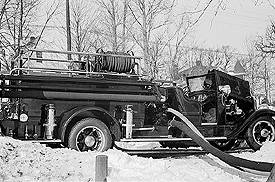
Ensign-Bickford’s plant consisted of many buildings for research and production, and the company also owned numerous homes in Simsbury to house their employees. Such exposures raised concerns within the company which ultimately led to the purchase of a 1935 American LaFrance pumper to suppress fires at these properties. A brigade was formed from their employees and once trained, they served not only the Ensign-Bickford Company, but the community of Simsbury as well.
The world was at war in 1944, and Simsbury was a town of nearly 4,000 people. Ensign-Bickford was an important supplier to the U.S. Government in the war effort, and because of the demand for increased production, coupled with the loss of employees due to the draft, the company found itself with inadequate resources to maintain a fire department. In January 1944, Ensign-Bickford Industries notified the Simsbury Board of Selectmen that they wished to terminate their participation in providing fire protection for the town.
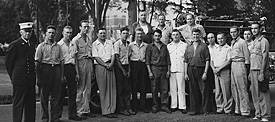
Simsbury acted quickly and organized a committee to resolve the issue. It was decided that a group of volunteers would be formed to take over fire fighting duties for the town. On April 12, 1944, Robert Pringle organized a group of interested men and these first volunteers would become the Simsbury Volunteer Fire Company. Draft-exemption was a prerequisite so that the group would not lose members as the Ensign-Bickford brigade had. Training was seen as a priority and twelve of the first seventeen volunteers were selected to attend a class in “Firefighting Techniques” sponsored by the Connecticut State Board of Education. The remaining five members were tasked with drafting the bylaws for the new Fire Company.
It became obvious that the new department had to be financed in some manner. A special meeting was held on June 5, 1944 and the Simsbury Fire District was created to finance the fire protection for the town. On that same evening, the newly-elected District Officers appointed the first Fire Commissioners who in turn named Lea Hutchinson as the first fire chief, a position he held for many years.
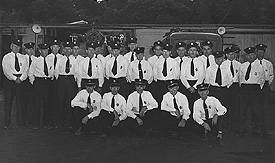
The volunteer ranks quickly grew to 26 members, and with things coming together, the members elected to incorporate and become the Simsbury Volunteer Fire Company on June 29, 1944.
With the Company formed and a group ready to serve, there was a need for equipment. On July 2, 1944, Ensign-Bickford Industries turned over their 1935 American LaFrance pumper to the Simsbury Volunteer Fire Company who was now in the business of providing fire protection to the Town of Simsbury. This apparatus would become known as Engine 1.
The Company and District would begin to grow almost immediately, and would continue to grow along with the town. The war not only meant shortages on manpower, but also shortages of materials. Through the dedication and ingenuity of the Company’s members, these obstacles would be overcome.
This spirit first manifested itself when it was recognized that there was a need to get water to outlying areas which weren’t covered by the local water system. In August 1944, a tank truck capable of carrying 1,050 gallons of water and pumping 500 GPM was purchased from the U.S. Treasury Department. By today’s standards, this sounds more like a pumper than a tanker, but at the time, carrying a 1,050 gallons of water to the scene was an amazing feat.
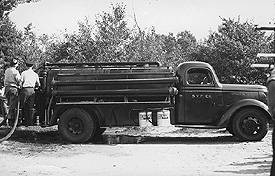
The members of the Company went to work repairing the truck. The pumping system was built with old steam valves from a discarded sawmill, the bumper made from pieces of an old bridge, and the running boards and other steel work were made from an old brine tank donated by a farmer as a reward for doing a good job at a fire at his place. Engine 2 was now on the line and answered its first call just 31 days after it rolled into town.
With the war over, the town continued to grow and more equipment was needed to cover the outlying areas. None the less, prosperity didn’t over-ride thrift. An agreement was reached between the Company and the District, that if the District would supply a chassis, the Company would build another tank truck. Under the direction of member Carl Banks, and at his garage in Weatogue, a 600 gallon tank truck was constructed from new materials and Engine 4 was placed into service in 1948 after having passed an Underwriter’s Test.
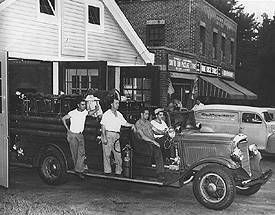
Housing the rapidly-growing apparatus fleet was challenging too. The original West Simsbury Station was a hay barn located in the center of West Simsbury village. It was utilized for many years until members of the Company built a new West Simsbury Station in 1962, and the barn subsequently returned to its original use. Another barn was utilized to house apparatus for some time on the east side of the Farmington River because of the weight restrictions placed on the bridges of the day. Then in 1952, Company members once again came together to build another fire station, Bushy Hill.
More can be learned about the history of our apparatus fleet and fire stations in their respective sections.
Until 1983, the Tariffville Volunteer Fire Company provided fire protection for the village of Tariffville, located in the northeast section of Simsbury. The Company was formed in 1939 because the citizens of Tariffville felt that it took Ensign-Bickford too long to respond to fires in their section of town. On June 30, 1983, the Tariffville Volunteer Fire Company was dissolved, the members who wished to join the Simsbury Volunteer Fire Company did so, and the Simsbury Fire District took possession of the Tariffville Station and their apparatus, and assumed responsibility for providing fire protection in the Village of Tariffville.
The Simsbury Volunteer Fire Company celebrated its 50th anniversary in 1994. Wanting to mark the occasion, the anniversary committee elected to present the town and citizens of Simsbury with a cast iron clock as a token of appreciation for all the support the Fire company had received through the years.
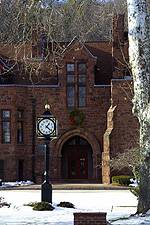
The anniversary committee went about the task of seeking funding for the project. In a generous gesture of support and appreciation for the Fire Company, the Ensign-Bickford Foundation offered to completely fund the project. The Boston Clock graces the front lawn of Simsbury’s town hall and was dedicated on December 13, 1994.
While the Fire District provides the financial support for the fire protection within our town, the Simsbury Volunteer Fire Company provides the operational support. The Simsbury Volunteer Fire Company and the Simsbury Fire District are two institutions who have served the community very well through the years, which is why both have survived since their inception, evolving into the first-class fire department which serves the citizens of Simsbury today.

